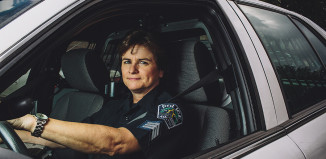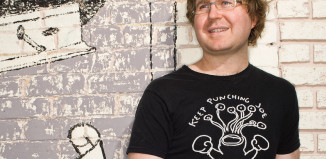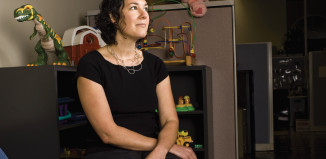Entering Theatre Action Project’s 1,600-square-foot labyrinthine office in East Austin, the first thing most visitors notice is an abundance of color. Vividly decorated creatures and masks hang from the ceiling as oversized papier-mâché puppets peer down on stacks of brilliantly colored fabrics and shelving stacked with construction paper, molding clay, markers, paint and scores of other art supplies.
In a far corner, plastic bags are piled several feet high, corners of bright, folded paper peeking through openings. “These are some of our peace cranes,” says Karen LaShelle, executive and artistic director for Theatre Action Project, or TAP. “This isn’t even the tip of the iceberg; we’ve got tons more in storage.”
The folded origami birds were part of a massive arts project for last year’s First Night Austin celebration. With the help of TAP’s teaching artists and volunteers, children from elementary and middle schools throughout Austin created an astounding 5,000 peace cranes, each adorned with hand-written messages about effecting peace.
“We were working with kids to develop spectacles on a theme, and then came together for the First Night procession,” LaShelle explains. “For this project, the overarching idea was ‘How can you become part of making peace in your own community?’”
The idea for the project stems from The Sadako Story, the tale of a Japanese girl who suffered the effects of leukemia after the atom bomb was dropped on Hiroshima, Japan. Familiar with a Japanese tradition that claims anyone who folds 1,000 paper cranes is granted a wish, Sadako set out to make enough cranes to help her become well again. Though she completed more than 1,000 cranes, she died at the age of 12, but inspired people the world over with her story, including those at TAP, who plan to send their origami cranes to Hiroshima Peace Park in Japan, where a monument to Sadako stands.
“It was a great way for local kids to really connect with the rest of the world,” LaShelle says, “and have fun, too.”
This is just one of the many activities TAP has involved kids in since its humble beginnings 11 years ago. Founded by three University of Texas graduate students, TAP started as an interactive play for school- children that addressed school violence. The show was a success, and soon the organization and its programming expanded. By next year, LaShelle hopes to have 11 full-time staffers, 45 teaching artists and a $1 million budget for TAP.
Through theater and education techniques, TAP works with more than 12,000 kids in Central Texas each year. The nonprofit’s mission is to create socially relevant, interactive theater and educational programming that sparks community dialogue, self-discovery and social change. To that end, the group offers four core programs for area youth.
In the Interactive Performance Residencies, acting teachers work with kids through puppet shows, role-playing and other activities that speak to themes of social justice children can relate to like bullying and conflict resolution. The Youth for Youth Theatre Companies program has four teen theater groups create original interactive shows based on their own experiences. The companies tour schools throughout the year, educating their peers on issues like dating violence, immigration and healthy lifestyle choices.
TAP After School Classes enable teaching artists to work with kids through arts-and-crafts activities, writing and acting, and other endeavors that teach kids to think creatively and work as a team while exploring socially relevant themes and topics. TAP in the Community uses theater as a tool for strengthening community, and projects often include interactive workshops and special events such as the First Night Austin procession for which the thousands of origami cranes were made.
Though TAP does not speak specifically to issues of gay acceptance, diversity is a topic TAP staff and volunteers regularly incorporate in their programs. “We don’t have any GLBT-related programming,” LaShelle says, “but we talk a lot about accepting diversity as a part of basic compassion. We also teach about acceptance of different cultures, issues involving race and overall social-justice issues.”
Looking toward the future, LaShelle says she hopes to continue growing TAP’s staff and volunteer numbers, as well as the organization’s budget and revenue sources. But overall, she’d like to be able to reach more kids.
“I think the kids really get our work. When you see their faces and reactions to the performances and interactive pieces, you know it’s working; we’re reaching them,” LaShelle says. “Moving forward, we’re really looking to expand our programming so that more young people from all over the city can be a part of TAP.”




































